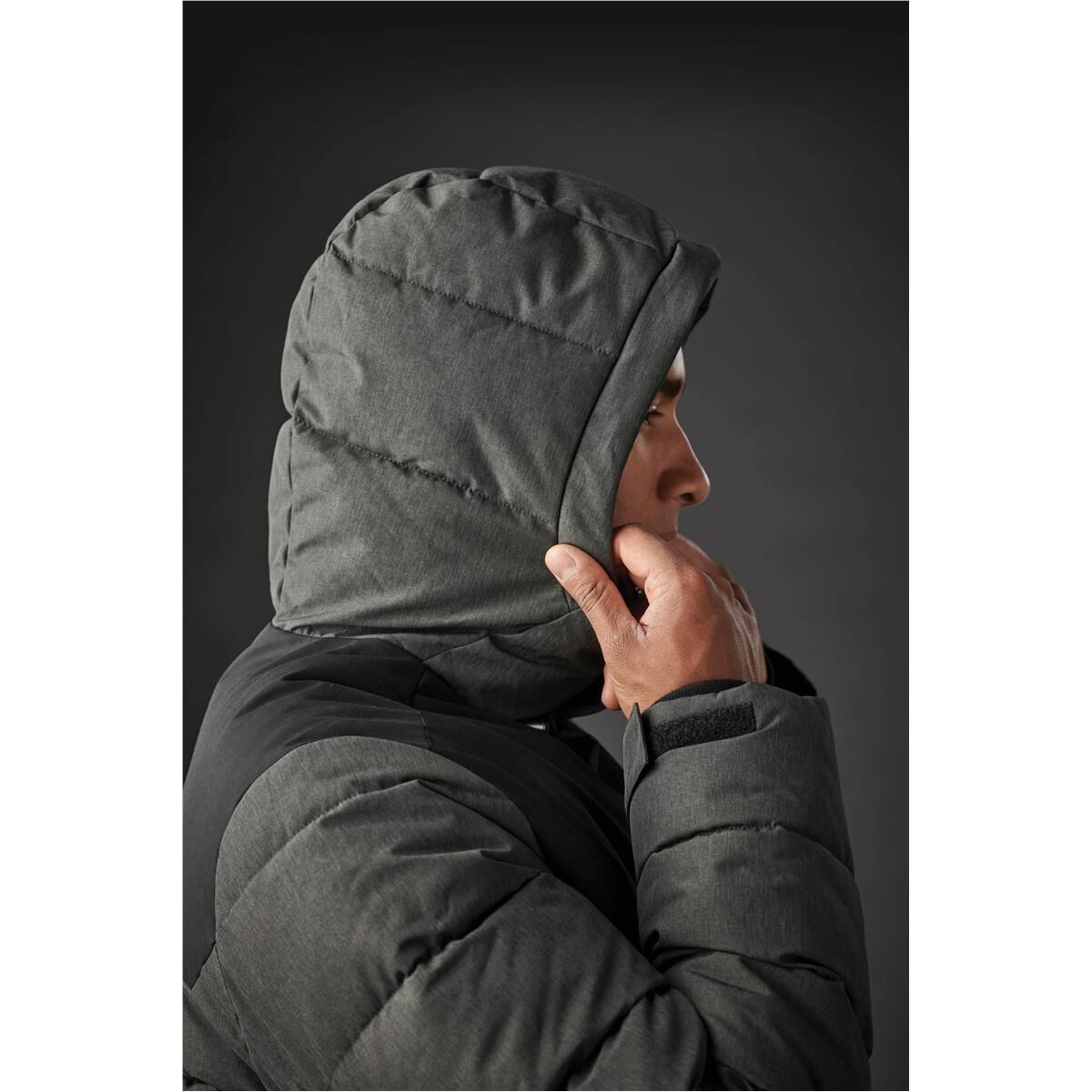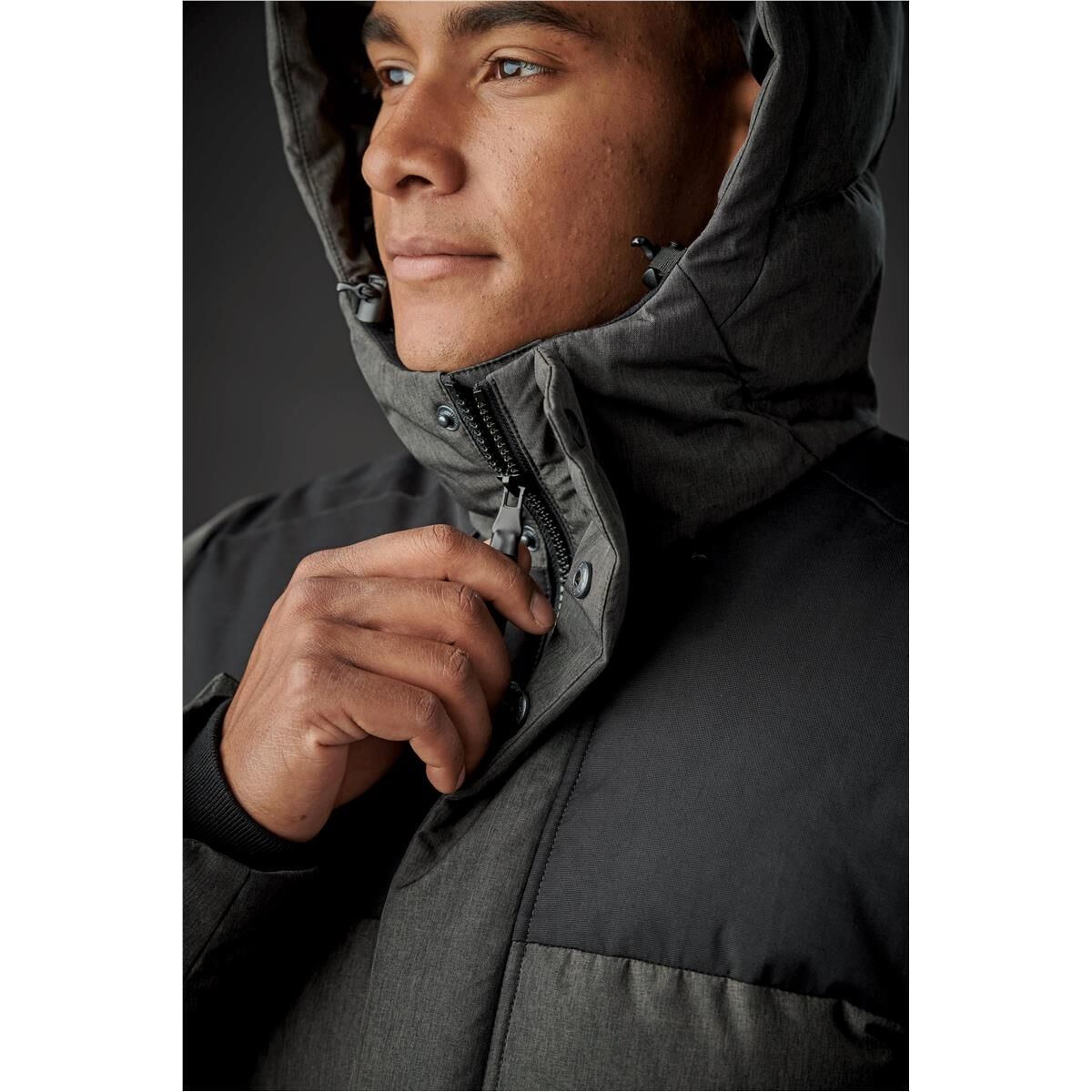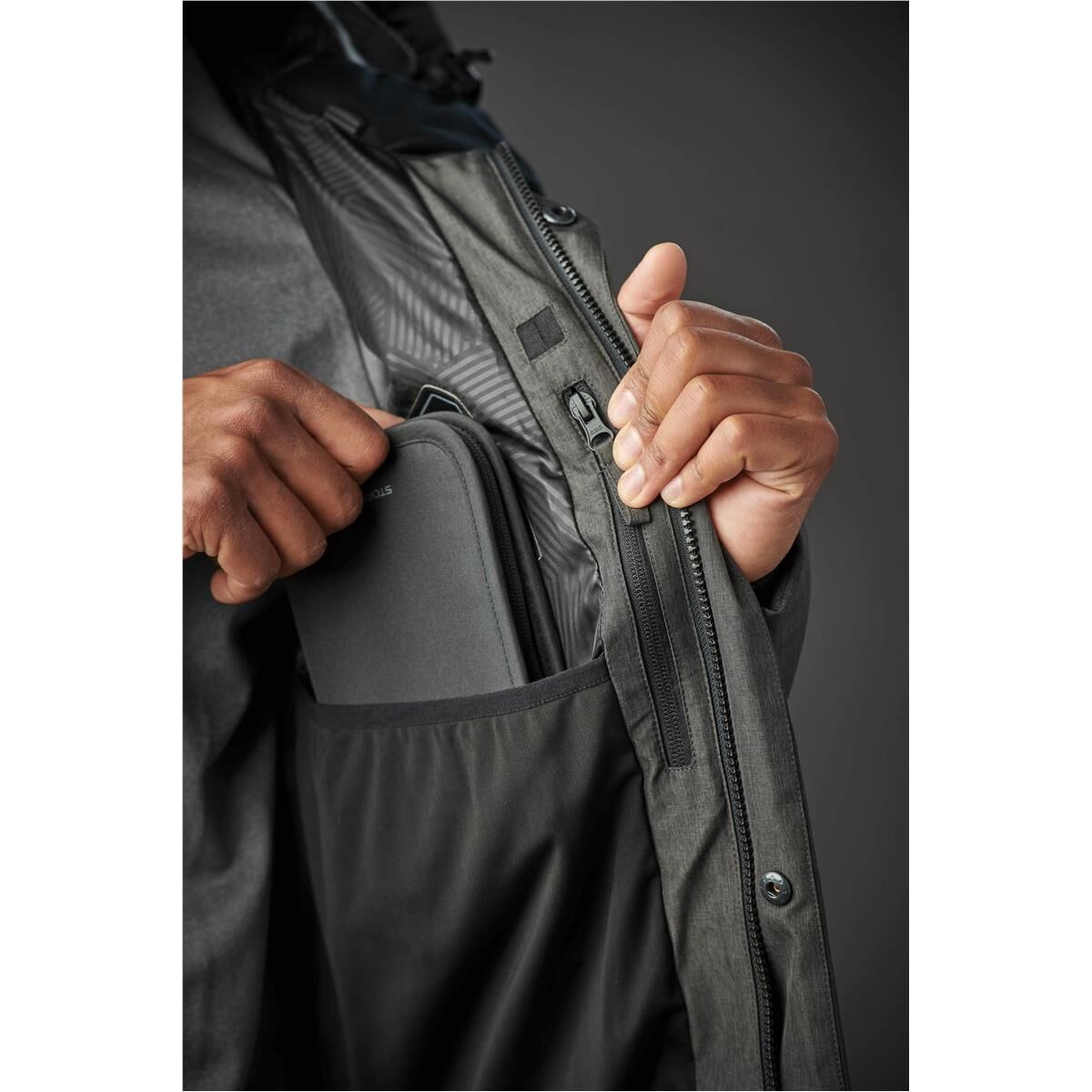Description
High style and extreme performance. Urban fashion and function effortlessly combine to deliver warmth and comfort as you take to the city streets in the three-quarter length, quilted Oslo HD Parka. H2XTREME® outershell with full-length external storm placket, storm cuffs and a fully adjustable thermal hood -is designed to provide wing with waterproof/breathable technology, storm hood face shield, articulated maximum protection for your head, neck and face, deliver warmth and comfort in both urban and extreme outdoor environments.
• STORMTECH H2XTREME® 5,000mm / 5,000g/m2 Waterproof / Breathable Outer Shell
• Temperature Rating: Extreme Cold 0°C (32°F) to -20°C (-4°F)
• PFC-Free Durable Water Repellent Finish
• Quilted Parka with Synthetic Fiber Fill
• Internal and External Stormflap
• Full Coverage, Insulated Storm Hood with Face Shield
• Extended Storm Placket with Chin Guard
• Internal Media & Goggle Pocket
• Storm Cuffs
• 2-Way Front Zipper
• Internal Zipper Pocket
• Decoration Access
• (Shell) 100% Polyester, 4.42oz/yd2 (USA) / 150gsm (CDN)
• (Shell – Secondary) 100% Nylon, 4.22oz/yd2 (USA) / 143gsm (CDN)
Additional information
| Colour | Heather Grey |
|---|---|
| Decoration | Small Embroidery up to 5K stitches, Medium Embroidery up to 10k stitches, Large Embroidery up to 15K Stitches 18cm wide, Extra Large Embroidery 20k embroidery over 18cm, Small Full colour digital Transfer 10x10cm (SuperColour), A4 Full colour digital Transfer (SuperColour), A3 Full colour digital Transfer (SuperColour), 1 Colour ScreenPrint (light colours only), 2 Colour ScreenPrint (light colours only), 3 Colour ScreenPrint (light colours only), 4 Colour ScreenPrint (light colours only), 1 Colour ScreenPrint (dark colours only), 2 Colour ScreenPrint (dark colours only), 3 Colour ScreenPrint (dark colours only), 4 Colour ScreenPrint (dark colours only), None |
| Decoration 2 | None, Small Embroidery up to 5K stitches, Medium Embroidery up to 10k stitches, Large Embroidery up to 15K Stitches 18cm wide, Extra Large Embroidery 20k embroidery over 18cm, Small Full colour digital Transfer 10x10cm (SuperColour), A4 Full colour digital Transfer (SuperColour), A3 Full colour digital Transfer (SuperColour), 1 Colour ScreenPrint (light colours only), 2 Colour ScreenPrint (light colours only), 3 Colour ScreenPrint (light colours only), 4 Colour ScreenPrint (light colours only), 1 Colour ScreenPrint (dark colours only), 2 Colour ScreenPrint (dark colours only), 3 Colour ScreenPrint (dark colours only), 4 Colour ScreenPrint (dark colours only) |
| Decoration 3 | None, Small Embroidery up to 5K stitches, Medium Embroidery up to 10k stitches, Small Full colour digital Transfer 10x10cm (SuperColour), 1 Colour ScreenPrint (light colours only), 2 Colour ScreenPrint (light colours only), 3 Colour ScreenPrint (light colours only), 4 Colour ScreenPrint (light colours only), 1 Colour ScreenPrint (dark colours only), 2 Colour ScreenPrint (dark colours only), 3 Colour ScreenPrint (dark colours only), 4 Colour ScreenPrint (dark colours only) |
| Optional | None, Poly Bagging, Embroidered names up to 2k stitches, Polly Bagging, Names up to 12cm wide Powerprint, Screen printed Neck label |
| Material | Nylon, Polyester |
| Production Time | 2-3 Weeks Production Time |
Our guarantee
All of our products are fully guaranteed to work, look and feel as designed.
Our most highly regarded company value at Good Things is integrity. We do what we say we are going to do in a timely fashion. We get "Back in a Flash" to all our clients for quotes, artwork and samples.
It is essential in our industry - from meeting delivery deadlines, through to having a product match a sample when delivered to each minute detail.
When dealing with us you can expect to get exactly what you ordered: as agreed, and on time. That is the Good Things Guarantee.
Product reviews
Men’s Oslo HD Parka
Min Qty: 25
99.4% jobs
delivered on-time
Free graphic
design
Quotes within
24 hours
Get an instant quote
Description
High style and extreme performance. Urban fashion and function effortlessly combine to deliver warmth and comfort as you take to the city streets in the three-quarter length, quilted Oslo HD Parka. H2XTREME® outershell with full-length external storm placket, storm cuffs and a fully adjustable thermal hood -is designed to provide wing with waterproof/breathable technology, storm hood face shield, articulated maximum protection for your head, neck and face, deliver warmth and comfort in both urban and extreme outdoor environments.
• STORMTECH H2XTREME® 5,000mm / 5,000g/m2 Waterproof / Breathable Outer Shell
• Temperature Rating: Extreme Cold 0°C (32°F) to -20°C (-4°F)
• PFC-Free Durable Water Repellent Finish
• Quilted Parka with Synthetic Fiber Fill
• Internal and External Stormflap
• Full Coverage, Insulated Storm Hood with Face Shield
• Extended Storm Placket with Chin Guard
• Internal Media & Goggle Pocket
• Storm Cuffs
• 2-Way Front Zipper
• Internal Zipper Pocket
• Decoration Access
• (Shell) 100% Polyester, 4.42oz/yd2 (USA) / 150gsm (CDN)
• (Shell – Secondary) 100% Nylon, 4.22oz/yd2 (USA) / 143gsm (CDN)
Additional information
| Colour | Heather Grey |
|---|---|
| Decoration | Small Embroidery up to 5K stitches, Medium Embroidery up to 10k stitches, Large Embroidery up to 15K Stitches 18cm wide, Extra Large Embroidery 20k embroidery over 18cm, Small Full colour digital Transfer 10x10cm (SuperColour), A4 Full colour digital Transfer (SuperColour), A3 Full colour digital Transfer (SuperColour), 1 Colour ScreenPrint (light colours only), 2 Colour ScreenPrint (light colours only), 3 Colour ScreenPrint (light colours only), 4 Colour ScreenPrint (light colours only), 1 Colour ScreenPrint (dark colours only), 2 Colour ScreenPrint (dark colours only), 3 Colour ScreenPrint (dark colours only), 4 Colour ScreenPrint (dark colours only), None |
| Decoration 2 | None, Small Embroidery up to 5K stitches, Medium Embroidery up to 10k stitches, Large Embroidery up to 15K Stitches 18cm wide, Extra Large Embroidery 20k embroidery over 18cm, Small Full colour digital Transfer 10x10cm (SuperColour), A4 Full colour digital Transfer (SuperColour), A3 Full colour digital Transfer (SuperColour), 1 Colour ScreenPrint (light colours only), 2 Colour ScreenPrint (light colours only), 3 Colour ScreenPrint (light colours only), 4 Colour ScreenPrint (light colours only), 1 Colour ScreenPrint (dark colours only), 2 Colour ScreenPrint (dark colours only), 3 Colour ScreenPrint (dark colours only), 4 Colour ScreenPrint (dark colours only) |
| Decoration 3 | None, Small Embroidery up to 5K stitches, Medium Embroidery up to 10k stitches, Small Full colour digital Transfer 10x10cm (SuperColour), 1 Colour ScreenPrint (light colours only), 2 Colour ScreenPrint (light colours only), 3 Colour ScreenPrint (light colours only), 4 Colour ScreenPrint (light colours only), 1 Colour ScreenPrint (dark colours only), 2 Colour ScreenPrint (dark colours only), 3 Colour ScreenPrint (dark colours only), 4 Colour ScreenPrint (dark colours only) |
| Optional | None, Poly Bagging, Embroidered names up to 2k stitches, Polly Bagging, Names up to 12cm wide Powerprint, Screen printed Neck label |
| Material | Nylon, Polyester |
| Production Time | 2-3 Weeks Production Time |
Our guarantee
All of our products are fully guaranteed to work, look and feel as designed.
Our most highly regarded company value at Good Things is integrity. We do what we say we are going to do in a timely fashion. We get "Back in a Flash" to all our clients for quotes, artwork and samples.
It is essential in our industry - from meeting delivery deadlines, through to having a product match a sample when delivered to each minute detail.
When dealing with us you can expect to get exactly what you ordered: as agreed, and on time. That is the Good Things Guarantee.




